Spring turkey season ends May 10
Turkey hunters have until May 10 to bag a gobbler for the 2020 spring wild turkey season. The bag limit is one bearded or male turkey. Check out our Where to Hunt map for hunting grounds near you. Find a list of locations not requiring a pre-season draw under “Spring Turkey Hunt Locations.”
View turkey hunting resources, including turkey aging information and processing videos, on our website.
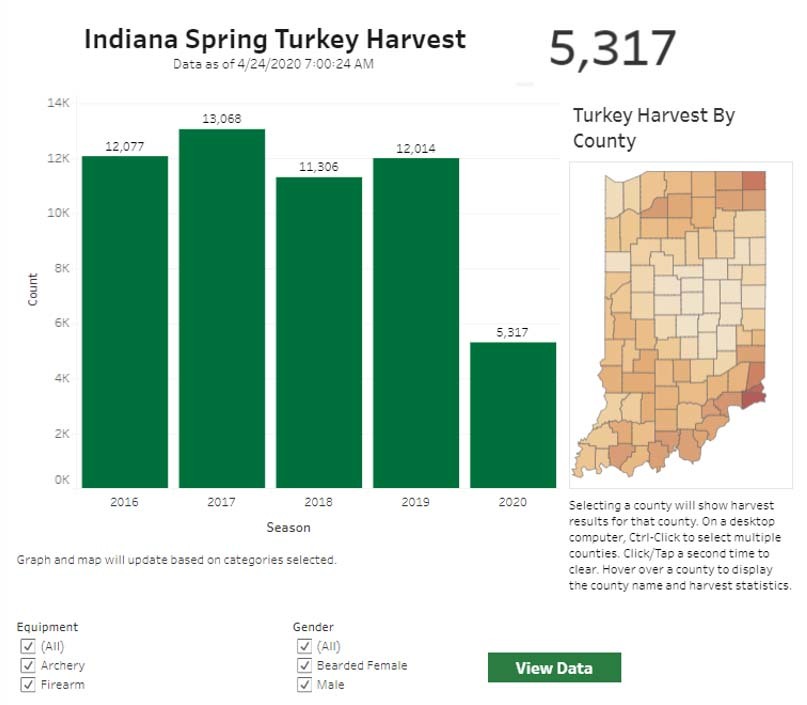 Explore our new spring turkey harvest website
Indiana DNR launched a new interactive website allowing turkey hunters to access spring turkey harvest data as it is collected by the state. Harvest data is updated daily during the spring turkey season.
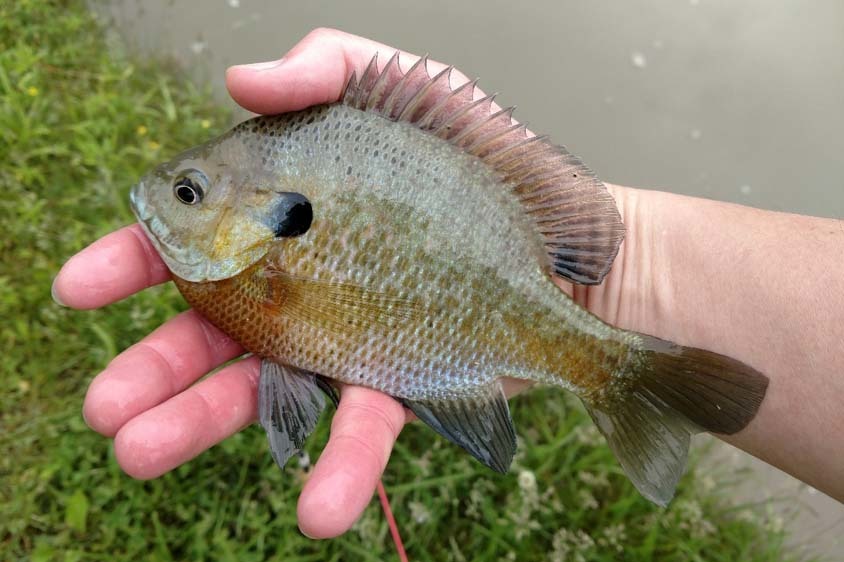 May weather brings about a fishing frenzy
May is a wonderful time to go fishing – longer, sunny days mean the water is warming and the fish are biting.
- April’s stocked trout are actively cruising ponds and streams in cooler waters. Find information on stocked locations in our 2020 trout stocking plan.
- You can catch Lake Michigan coho and chinook salmon from a pier or boat using our tips and tricks for shore fishing and trolling.
- In early May, you may be able to catch white bass as they run up tailwaters and other streams.
- Visit one of our prime muskie fishing locations and reel in a big one.
- Crappie have already moved into shallower waters to spawn – find fishing tips on our website.
- Largemouth bass, bluegill, and redear all start to spawn when the temperature reaches 65 degrees – they will be busy feeding in the shallows and defending their nests.
- Walleye fishing in tailwaters depends greatly on the discharge from dams, but fishing can be excellent through May. When flows are high, fish migrate upstream toward the dam. Check out our list of great walleye fishing locations.
Not sure what to use as bait or a lure? As active as fish are now, they aren’t picky. They’ll bite artificial lures like spinners, jigs, and flies. Small hooks with red worms, bee moths, or crickets also work. Some aquatic insects will be hatching, so you may wish to match the hatch. The best thing to do is get out there and wet a line.
Catfish stocking continues at 10 urban locations

As part of DNR's urban fishing program, an estimated 5,000 channel catfish will be stocked this year at 10 lakes in urban areas. About 2,000 of those catfish were stocked in late April and early May, and an additional 1,000 will be stocked in early June.
The remaining 2,000 fish, originally scheduled for stocking this April, will be held for stocking in late September to coincide with the final Free Fishing Day (Sept. 26). Because they will be held longer, the catfish will be larger at the time of stocking in late September.
Read the release.
Learn more about the urban fishing program, stocked locations, and the fish being stocked.
|
2019-20 license extensions end May 22
The extension for 2019-20 annual licenses and stamps per Indiana Executive Order 20-08 ends May 22 at 11:59 p.m. After this date, those wishing to hunt and/or fish will need a valid 2020-21 license. Buy yours online or at a local retailer.
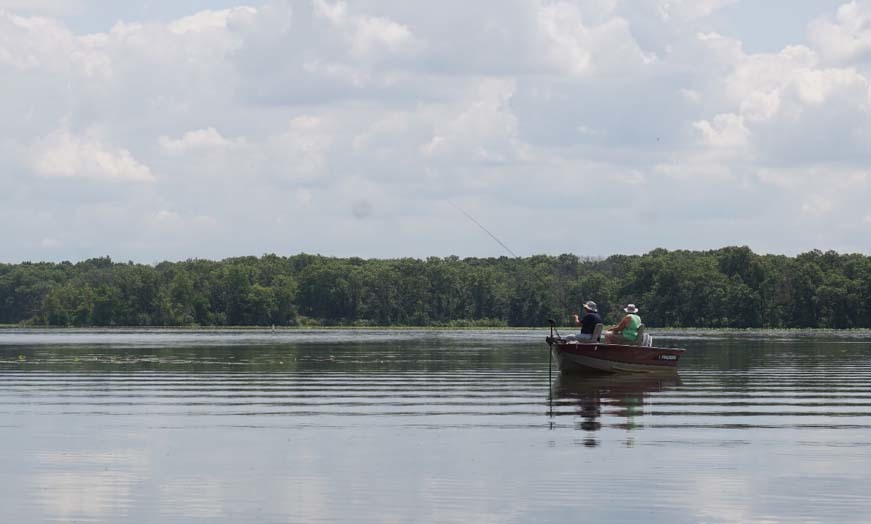 Fishing restrictions relaxed at Willow Slough FWA
Beginning May 1, all property-specific fishing regulations were lifted on J.C. Murphey Lake at Willow Slough Fish & Wildlife Area (FWA). Regulations at the Newton County lake were lifted in anticipation of upcoming renovations on the lake in 2022. Until further notice, bag and size limits will be the same as the statewide limits for other Indiana water bodies.
For more information, read the release or find statewide fishing regulations on our website.
Spawning season triggers natural fish die-offs
Warmer water temperatures trigger spawning activity for many of Indiana’s native fish species. These activities require a lot of energy and can weaken fish, leaving them susceptible to infections from diseases or parasites that can eventually kill them. Spawning activities can last for weeks and large numbers of fish may die. However, these events rarely have a lasting effect on the population.
If you find a large number of dead fish of several species or sizes, or a pollutant is suspected, please contact the Indiana DNR TIP line at 800-847-4367 or the Indiana Emergency Spill Line at 888-233-7745 or 317-233-7745.
Find more information on fish die-offs within our Indiana Fish Pond Management guide.
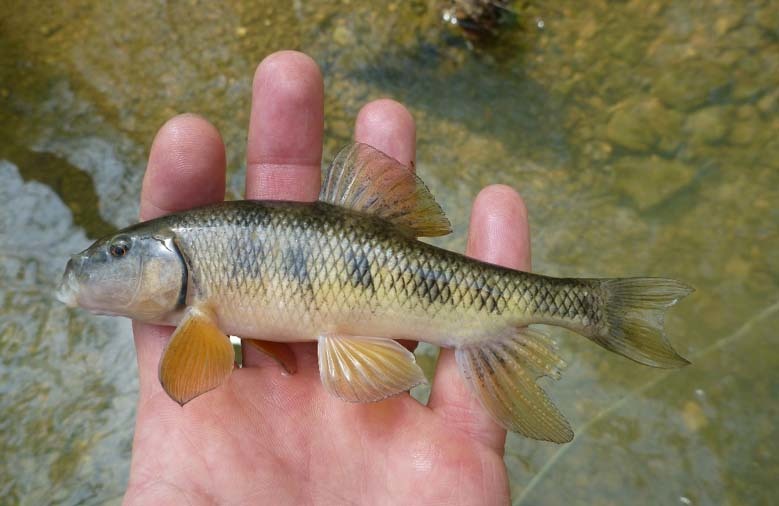 Need help identifying a fish?
Ever reeled in a line and had no idea what was on the other end? Send us the details and we’ll figure it out for you. Fill out our fish identification form and send photos or video to fishid@dnr.IN.gov.
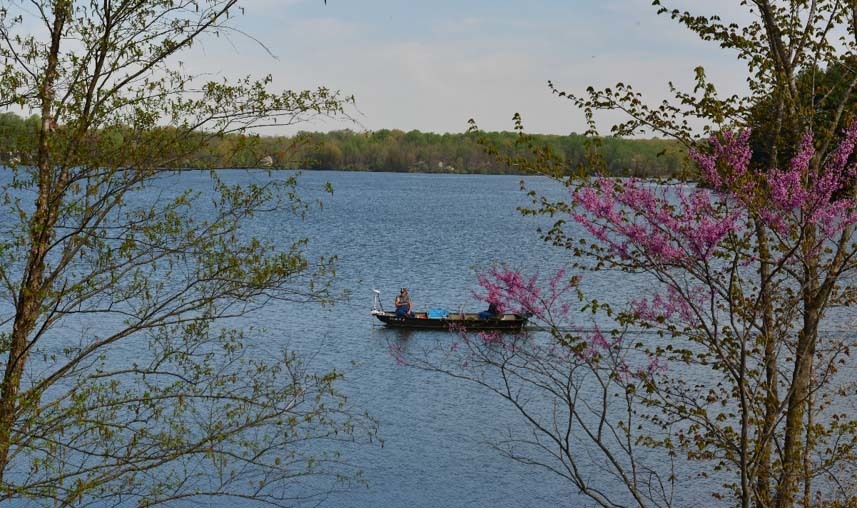 Clean, drain, and dry your watercraft
As more people get out on the water, the potential to spread aquatic invasive species increases. The DNR reminds boaters and others enjoying the water to get rid of aquatic hitchhikers by cleaning, draining, and drying their watercraft once they leave the water.
-
Clean all equipment that touched the water. This includes watercraft hulls, trailers, shoes, waders, life vests, engines, and other gear. Remove all visible plants, algae, animals, and mud.
-
Drain accumulated water from watercraft or gear, including live wells and transom wells, before leaving the ramp or public access point.
-
Dry all gear for at least five days before using it in a different water body.
Learn more about aquatic invasive species on our website.
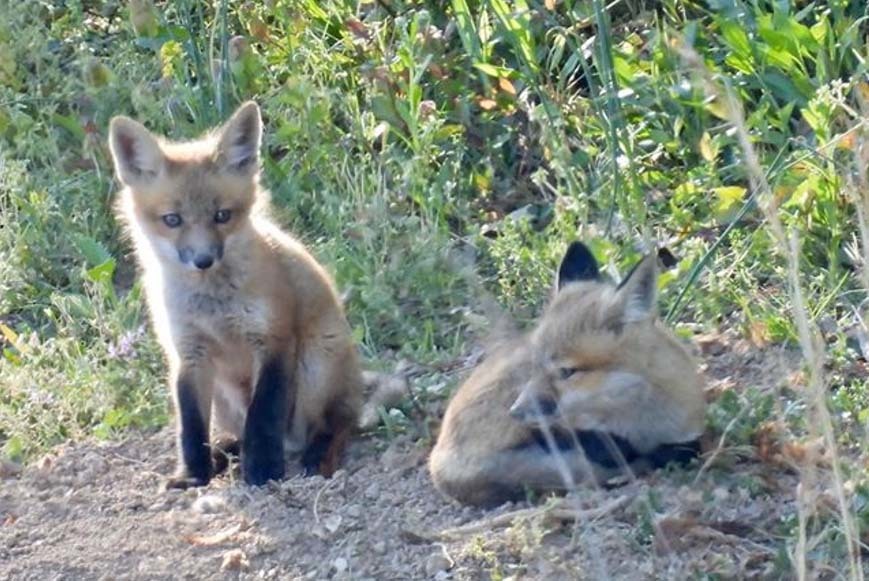 Photo courtesy of Bobbi Beckham Holloway.
Help us keep wildlife wild
|
Spring is here and with many of us stuck near home, we may notice new arrivals in our backyards. This time of year, many wild animals are born, including rabbits, squirrels, birds, and fawns. Other wildlife, like turtles, are on the move and more likely to be seen. While it’s easy to enjoy the great outdoors and practice social distancing from people, remember to practice social distancing from wildlife, too. Help us keep wildlife wild.
• Remember that adult animals rarely abandon their young – It is common for the parent to leave them while they search for food. Do not hover to see if a parent comes back; they won’t return if a person is standing nearby. Give the animal space and only check back periodically.
• Young wildlife should not be handled. They can carry diseases or parasites and are capable of inflicting damage by biting or scratching. Human scent can also alert predators to the young animal’s presence. However, nestlings and small mammals can be safely returned to their nests if they have fallen out and are uninjured. Once the animal has been returned safely, leave the area.
• Pets should be supervised at all times when outdoors. With so many young animals in nests, this keeps both pets and wildlife safe.
• Except for properly maintained birdfeeders, do not feed wildlife. Feeding wildlife can lead to loss of fear, conflicts, and diseases spreading. Creating habitat is a healthy alternative that provides both food and shelter.
• Help turtles cross roads, don’t take them home. May marks the beginning of turtle nesting season, and some species are endangered or of special concern. Let them continue to contribute to wild populations by only helping turtles cross roads. Be sure to move them in the direction they were heading once traffic has cleared.
While rescuing young wildlife is legal, keeping them is not. Truly orphaned wild animals must be given to a licensed wildlife rehabilitator within 24 hours to maximize their chance of survival. For more information about orphaned wildlife, visit on.IN.gov/keepwildlifewild.
|
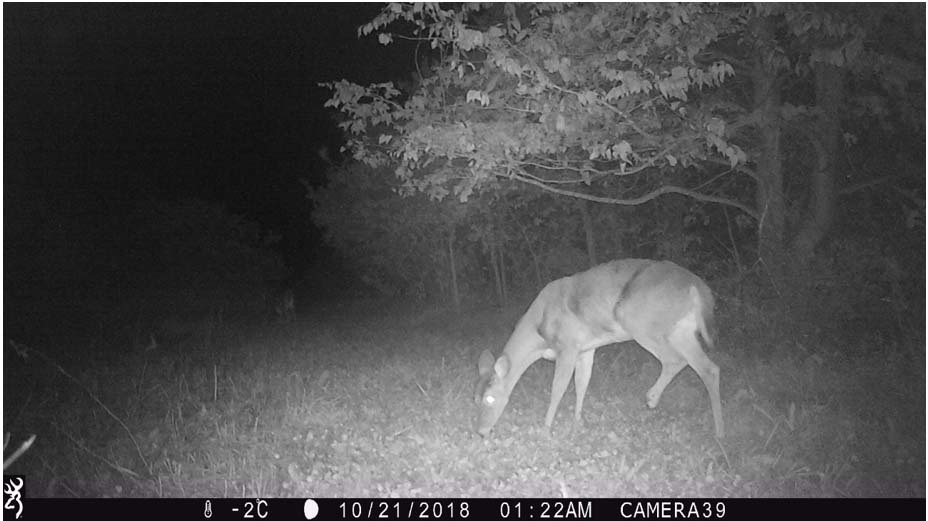 This doe looks injured, but may have actually been born without a hoof. Wildlife in this condition can be left alone – she is able to move and feed.
How to help injured wildlife
Do you know what to do if you find an injured wild animal? The first step is determining if it is actually injured. Clear signs of distress include: • Bleeding or clear signs of injuries such as bruises, cuts, punctures or broken bones • Looks thin, weak, cold or soaking wet • Signs of diarrhea • Flies, fly eggs, maggots, ticks, lice or fleas have infested the animal
If a wild animal shows any of these signs and is unable to move or run away effectively, it may be time to call a licensed wildlife rehabilitator for help. You can find a list of wildlife rehabilitators on our website.
Please note that the Indiana DNR does not provide services for injured or orphaned wildlife. We rely on licensed wildlife rehabilitators to assist with these situations.
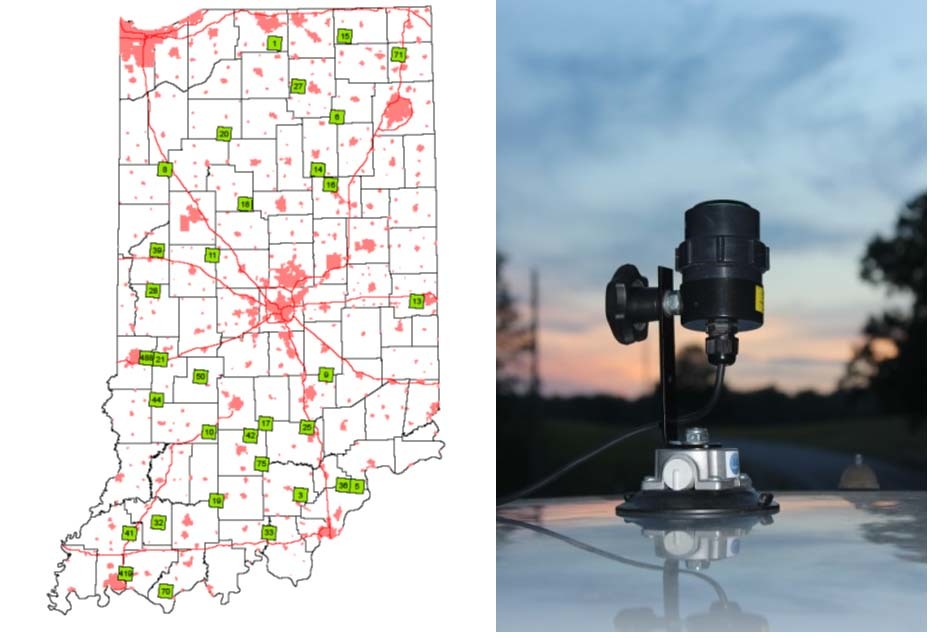 Acoustic bat surveys are conducted statewide. Red areas are urban zones and green squares are survey locations for the next 10 years.
Nongame Wildlife Fund at Work: Mammals
|
Indiana is home to 13 species of insectivorous bats, including one that earned a name here – the Indiana bat. As spring turns to summer, bats are locating roosts to raise their young all across Indiana’s habitats. Fortunately for Hoosiers, this means millions of insects will be gobbled up from our gardens and forests. DNR biologists use the bats’ main form of navigation, echolocation, as a way to identify their species. Using special microphones to record bat calls, DNR biologists can monitor trends in bat populations. This data originally helped show the impacts of white-nose syndrome on Indiana’s bat populations.
Now, more so than ever, donations to the Nongame Wildlife Fund are aiding biologists in conducting surveys for Indiana’s only flying mammals. This mobile acoustic bat survey (above) is one of multiple surveys biologists conduct with bats. Donations drive the research, but you can help too by monitoring bat roosts on your property, or signing up to be an acoustic surveyor. For more information on Indiana’s bats, visit our website. Consider donating to the Nongame Wildlife Fund to help bats and other rare or endangered species.
|
Recent news releases
Some fishing regulations at J.C. Murphey Lake to be lifted May 1
Trout season opens Saturday, April 25
DNR postpones some urban catfish stocking until September
LARE grants awarded for sediment or logjam removal and aquatic invasive plant control
Know state property restrictions during spring turkey hunting season, beginning April 18
New spring wild turkey harvest website available
More

About Fish and Wildlife Management in Indiana
Fish and wildlife management and public access are funded by fishing and hunting license revenue and also through the Wildlife and Sport Fish Restoration Programs administered by the U.S. Fish & Wildlife Service. These programs collect excise taxes on sporting arms and ammunition, archery equipment, fishing equipment, and motor boat fuels. The money is distributed among state fish and wildlife agencies based on land size and the number of licensed anglers and hunters in each state. Find out more information about fish and wildlife management in Indiana at Wildlife.IN.gov.
|